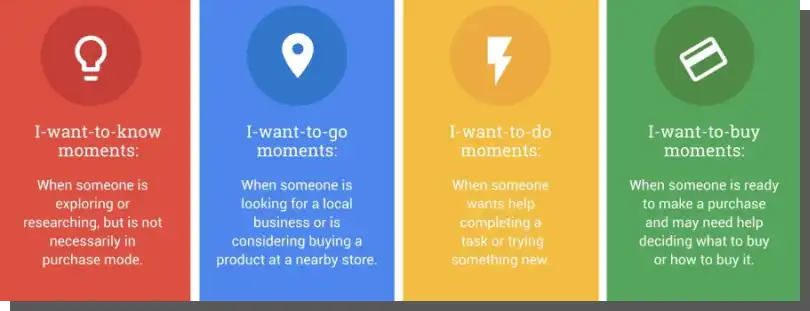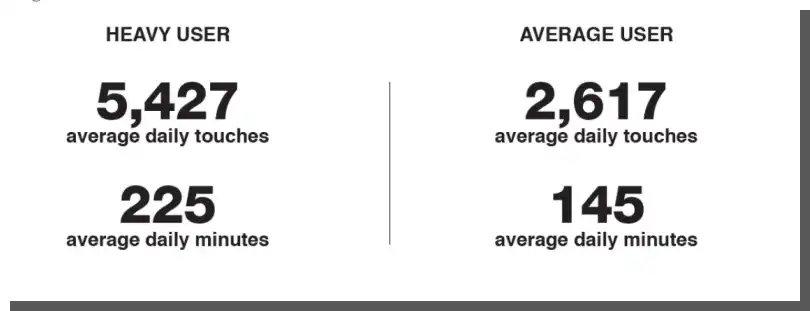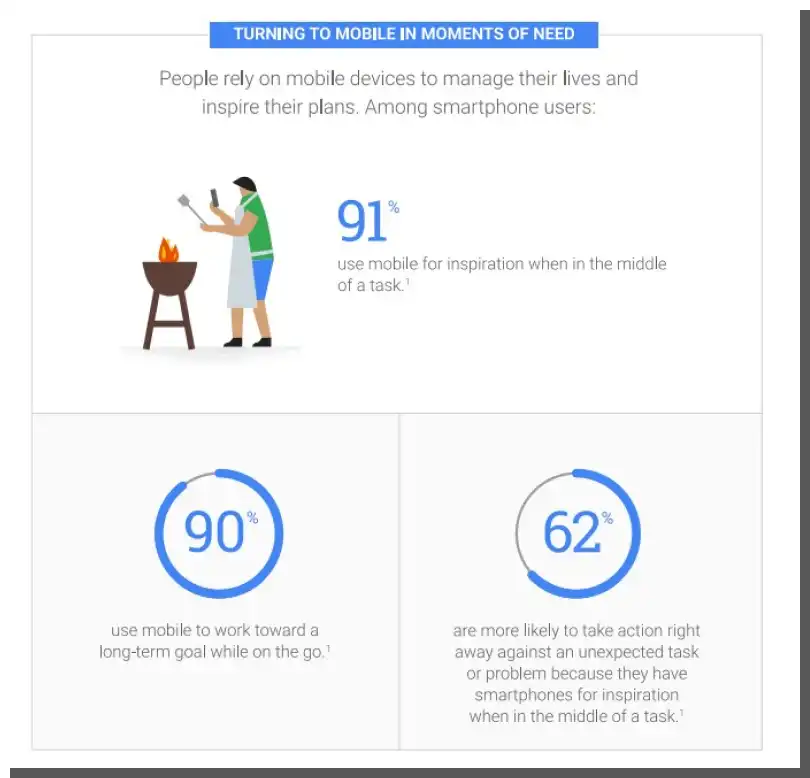It is 2015. The Google search engine introduces a new concept: Micro-moments.
Based on its research, Google defines Micro-moments as the "intent-rich moments in which mobile device users make decisions, specify their preferences and take action."
Google's micro-moments definition is very convincing. The entire User Journey and Customer Journey are filled with Micro-moments.
The full definition of Micro-moments developed by Google reads as follows:
Micro-moments occur when people reflexively turn to a device—increasingly a smartphone—to act on a need to learn something, do something, discover something, watch something, or buy something.
Micro-moments are not only useful for designing the user experience for mobile devices, but they can also be used for micro-moment marketing and marketing strategy.
What exactly are Google Micro-moments? How to use Micro-moments?
Micro-moments are largely impulsive, context-determined consumer behaviors having different reasons: from intentional and task-oriented to social to purely hedonistic and fun-related.
Oftentimes we reach for mobile phones spontaneously in situations where they serve entertainment while waiting (e.g., for a subway).
We treat the mobile device as a tool that enables us to:
- Know something, e.g., find information (I Want To Know Moments)
- Do something, e.g., someone wants help with something (I Want To Do Moments)
- Buy something, e.g., make a purchase (I Want To Buy Moments)
- Go somewhere, e.g., looking for a location such as a local business (I Want To Go Moments)
At Micro-moments, our expectations and our impatience tend to grow. We make decisions faster and expect a quicker reward for our efforts. We want to know more quickly and do something faster. Using mobile phones (or, more precisely, their applications and functions), we want to buy faster and move faster.

Since 2015, User Experience has been strongly determined by this new concept, and this is not an exaggeration. The changes in consumer behavior must entail a shift in thinking about usability.
What changes does it enforce? How to design web and mobile applications in the spirit of the Micro-moment concept? I will discuss these issues in this article.
Micro-moments in designing for mobile devices. How to use it?
Smartphones meet more and more needs, from cognitive needs to the need for self-realization and belonging. The phones have become multitasking tools, completely changing the rules of the game in sales and marketing (micro-moments marketing), but also web and mobile application design and the approach to usability. They conditioned consumers to expect brands to immediately deliver what they were looking for.
Initially, a little over the top, but quite rightly, in retrospect, Google perceives a fundamental change in these new consumer behavior patterns. The word "revolution" is not used, but the concept developed in Think with Google surely is not promoted as a curiosity. This is serious.
The scope of mobile phone use, the multitude of their functions, and hence the time of their use result in changes that are difficult to ignore. The anecdote cited by Muriel Garreta Domingo in her article "Micro-moments: Are you designing for them?" serves as enough evidence. Namely, over a decade, the average time devoted to a dinner in a restaurant extended by almost 100%. And this is because of mobile phones and Micro-moments.
Maybe this analogy is a bit far-fetched, but you must admit there is something to it. Micro-moments are a bit like impulsive shopping. They completely change the entire Consumer Journey, dividing it into many Micro-moments that are beginning to play a decisive role.
Application reaction time, quality, accuracy, and usability become indispensable for meeting the expectations of the customers who make purchasing decisions in an increasingly spontaneous and affective manner determined by the context and the specific nature of the medium.
From the point of view of phone and application functionality, you can see that Micro-moments are about convergence and relevance. They also become a path that leads people to an online store or desktop site.
Micro-moments are about the need to:
- Know that is met by search engines, comparison websites, recommendation systems and information aggregation, categorization, and customization applications
- Do something that is met by, e.g., booking applications
- Buy something that is met by store applications and their carts
- Go somewhere that is met by localization functions, navigation applications, and AR (Augmented Reality) based on them.
There is a close relationship between Micro-moments and functionalities, technologies, design, usability, and ultimately, sales and the implementation of business objectives. This rule is directly expressed as a recommendation by the Think with Google experts.
The design must focus on the following:
- Speed of delivery of useful and up-to-date information
- Context of need activation related to a location, situation, and relationships
- Presence understood as being ahead of the competition as regards attention and needs fulfillment.
Consequently, (operating) speed and authenticity (credibility and impartiality) become core values. The latter is crucial in Micro-moments related to the need to know.
Security is equally important, most strongly present when you want to make a purchase.
Micro-moments and seamless User Experience
Each day mobile phone users tap their screens 2,617 times. According to a Dscout study, Heavy Users interact with their phones as many as 5,427 times daily.

Can most, or maybe all, of the 2,617 interactions between a user and their phone be categorized as Micro-moments? Of course, not. Some of them are accidental, erroneous, inadvertent, and habitual taps.
So, not all of them are compliant with the definition of "I Want To Know Moments, I Want To Do Moments…", etc. However, we can confidently say that a significant portion of them is related to Micro-moments.
For application designers, researchers, and developers, this means the need also to consider seemingly insignificant interactions (Microinteractions; we will talk about them in a moment), which can be crucial when searching, selecting, and making decisions.
In practice, this means the need for:
- Re-identification of purchase decision-making moments
- Multichannel presence aimed at the fulfillment of one of the four needs expressed at Micro-moments and satisfied with a phone
- Identification of problems: use of the 5W method.
How to investigate Micro-moments?
One of the most effective methods for diagnosing Micro-moments is the 5W method based on five key questions: "Who?", "What?, "When?", "Where?" and "Why?".
The demographic data from analytical systems allow you to quantify "Who?" uses applications, and makes purchases. The analysis of keywords will enable you to determine "What?" is the main user attractor (e.g., content).

The "Who?" aspect is most closely connected with Micro-moments. It allows you to link (hourly, daily, and monthly) search trends with working hours and events.
Therefore, it allows you to create a cause-and-effect link that can be translated into specific design solutions and functionalities. The answer to the question "Where?" lets you know the circumstances in which queries, searches, purchases, and Microinteractions occur most often. "Why?" asks the reason.
The answers to these questions can be found in the answers to the previous questions, by analyzing them, hypothesizing, and trying to deduce the reasons.

Source: Think with Google
Looking at the issue of application relevance to Micro-moments, you can use the 5W method to describe a problem, specify the users, identify the sources of the problem (e.g., unattractive content), and set a time frame.
This last one can also be the source of the problem, e.g., inappropriate timing of database and information updating with the user needs. You are also able to identify the problem results and find their causes.
Solid, thorough and reliable research and analysis are the basis for all activities optimizing user experience at Micro-moments.
Considering that the time criterion plays a key role at Micro-moments, you should investigate the functionality first. But also the functionality, usability, intuitiveness, and speed of operation relevant to Micro-moments.
This brings us to the intersection of User Experience Design and Micro-moments.
This is the intersection of design practice and marketing theory. We have come to the concept of Microinteractions.
Micro-moments and Microinteractions - what are the differences?
These are not strictly identical concepts. They do not mean the same thing. Without going into tedious theoretical deliberations, let us just say that Microinteractions impact the success of Micro-moments. Therefore, their optimization is crucial for UX Design.
What is a Microinteraction? Let's hear Dan Saffer, the author of "Microinteractions".
According to his definition:
Microinteractions are the moments corresponding to the single use case. They do one thing only. Each time you change a setting, synchronize data or devices, set the alarm, select a password, log in, set a status message or like a favorite, you get involved in a Microinteraction.
Microinteractions work best for:
- Customizing settings
- Interactions with a single piece of data
- Controlling an ongoing process
- Browsing or creating small bits of content
- Activating and deactivating functions.

Dan Saffer distinguished four key parts or issues in Microinteraction design and optimization.
Microinteractions are loops. They are repetitive. A sequence is initiated by a Trigger. The sequence functions according to specific Rules. It consists in providing results but also Feedback. Loops & Modes, the last component in this structure, define meta-rules governing a given Microinteraction.
The better designed Microinteraction, the more transparent, invisible, and unconscious it is, performed automatically with minimum need for conscious engagement and psychic energy.
Microinteractions are largely responsible for how we evaluate, feel about and perceive digital products.
If we use them unconsciously, we will observe their positive effect on the User Journey and, more generally, on the Customer Journey. In this respect, a sign of bad design is that they are used consciously.
From the perspective of Micro-moment design, you should always think about Microinteractions systemically and holistically. UX design during Micro-moments and the interaction with an interface utilizing Microinteractions is a dual-experience design.
On the one hand, it is understood as a single satisfaction; on the other hand, as the entire experience that is not the sum of its parts. It is a value of higher order.
Consequently, the most practical tip resulting from this discussion is to focus the design process not so much on "what" as "how." In other words, “how it works” is more important than “what it is.”
When focusing on “what it is,” it is easy to dismiss its function, relevance, role and significance.
Another practical conclusion is to make the needs, crucial for a given Micro-moment, as accessible and visible as possible. Do you want to improve search? Place the window at the top in the screen's most convenient and visible location.
Do you want your users to access important information faster? Use tables of contents and direct links in highlighted fields. Minimize the effort and the number of taps necessary to achieve a given Micro-moment. Simplify the process. Consider the time required.
Micro-moments, or functionality optimization
The mobile device features and capabilities (e.g., geolocation or variable Internet access conditioned by technical infrastructure) can be used to improve the User Experience.
They are particularly relevant to Micro-moments. The more so that the manner of use and satisfaction from the use of mobile phones are strongly context-related.
For example, a connectivity issue or a problem with Internet access is not uncommon. Therefore, it is worth providing selected web application functionalities also offline (it is possible in, e.g., Progressive Web Apps (PWA)).
The possibility to determine the user's location and their speed and direction of movement allows you to "anticipate" obstacles in the device use (e.g., the above-mentioned Internet access but also issues related to navigation, data input, or reading). The possibility to listen instead of reading on the move builds a much better experience.
Micro-moments. Summary
- Each day an average mobile phone user taps the screen 2,617 times.
- Each tap is a Microinteraction between a device and a user.
- Microinteractions serve single tasks.
- The course of Microinteraction determines how users evaluate, feel about, and perceive digital products.
- Well-designed Microinteractions are transparent, invisible, and unconscious.
- Micro-moments and Microinteractions are not synonymous.
- Microinteractions directly affect the course of Micro-moments.
- Micro-moments are defined as the moments in which mobile device users make decisions, specify their preferences and take action.
- Micro-moments are largely impulsive, context-determined consumer behaviors.
- Micro-moments are expressed in 4 needs: to know, to do, to buy, and to go.
- At Micro-moments, we make decisions faster and expect a quicker reward for our efforts.
- One of the most effective methods for optimizing Micro-moments is the 5W method.
- From the Micro moment design and optimization perspective, you should always think about Micro-interactions systemically and holistically.
- User Experience Design is currently focused on designing and optimizing Micro-moments and Micro-interactions.






